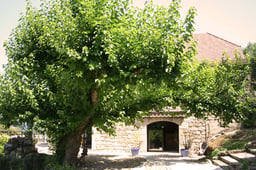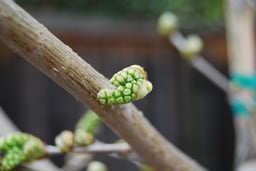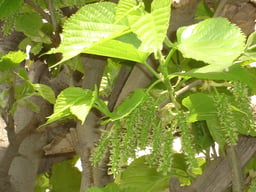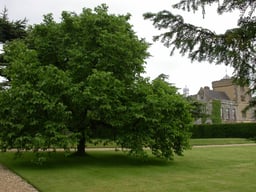Morus (plant)
-BDn03aKa2C04YIN5xGJ9ikZC4tZLBT)
Morus (plant)
-BDn03aKa2C04YIN5xGJ9ikZC4tZLBT)
| Mulberry | |
|---|---|
| Morus nigra | |
| Scientific classification | |
| Kingdom: | Plantae |
| Clade: | Angiosperms |
| Clade: | Eudicots |
| Clade: | Rosids |
| Order: | Rosales |
| Family: | Moraceae |
| Tribe: | Moreae |
| Genus: | Morus L. |
| Species | |
| See text. | |
| Nutritional value per 100 g (3.5 oz) | |
| Energy | 180 kJ (43 kcal) |
9.8 | |
| Sugars | 8.1 |
| Dietary fiber | 1.7 |
Fat | 0.39 |
Protein | 1.44 |
| Vitamins | Quantity%DV† |
| Vitamin A equiv. | 0% 1 μg |
| Thiamine (B1) | 3% 0.029 mg |
| Riboflavin (B2) | 8% 0.101 mg |
| Niacin (B3) | 4% 0.62 mg |
| Vitamin B6 | 4% 0.05 mg |
| Folate (B9) | 2% 6 μg |
| Vitamin C | 44% 36.4 mg |
| Vitamin E | 6% 0.87 mg |
| Vitamin K | 7% 7.8 μg |
| Minerals | Quantity%DV† |
| Calcium | 4% 39 mg |
| Iron | 14% 1.85 mg |
| Magnesium | 5% 18 mg |
| Phosphorus | 5% 38 mg |
| Potassium | 4% 194 mg |
| Sodium | 1% 10 mg |
| Zinc | 1% 0.12 mg |
| Other constituents | Quantity |
| Water | 87.68 g |
Link to United States Department of Agriculture Database entry [39] | |
| |
| †Percentages are roughly approximated using US recommendations for adults. Source: USDA Nutrient Database [40] | |
Morus, a genus of flowering plants in the family Moraceae, comprises 10–16 species of deciduous trees commonly known as mulberries, growing wild and under cultivation in many temperate world regions.[1]
The closely related genus Broussonetia is also commonly known as mulberry, notably the paper mulberry, Broussonetia papyrifera.[2]
Mulberries are fast-growing when young, but soon become slow-growing and rarely exceed 10–15 m (30–50 ft) tall. The leaves are alternately arranged, simple, and often lobed and serrated on the margin. Lobes are more common on juvenile shoots than on mature trees. The trees can be monoecious or dioecious.[3][4] The mulberry fruit is a multiple fruit, about 2–3 cm (3⁄4–1 1⁄4 in) long. Immature fruits are white, green, or pale yellow. In most species, the fruit turn pink and then red while ripening, then dark purple or black, and have a sweet flavor when fully ripe. The fruit of the white-fruited cultivar are white when ripe; the fruit of this cultivar are also sweet, but have a mild flavor compared with darker varieties. Although quite similar looking, they are not to be confused with blackberries.
| Mulberry | |
|---|---|
| Morus nigra | |
| Scientific classification | |
| Kingdom: | Plantae |
| Clade: | Angiosperms |
| Clade: | Eudicots |
| Clade: | Rosids |
| Order: | Rosales |
| Family: | Moraceae |
| Tribe: | Moreae |
| Genus: | Morus L. |
| Species | |
| See text. | |
| Nutritional value per 100 g (3.5 oz) | |
| Energy | 180 kJ (43 kcal) |
9.8 | |
| Sugars | 8.1 |
| Dietary fiber | 1.7 |
Fat | 0.39 |
Protein | 1.44 |
| Vitamins | Quantity%DV† |
| Vitamin A equiv. | 0% 1 μg |
| Thiamine (B1) | 3% 0.029 mg |
| Riboflavin (B2) | 8% 0.101 mg |
| Niacin (B3) | 4% 0.62 mg |
| Vitamin B6 | 4% 0.05 mg |
| Folate (B9) | 2% 6 μg |
| Vitamin C | 44% 36.4 mg |
| Vitamin E | 6% 0.87 mg |
| Vitamin K | 7% 7.8 μg |
| Minerals | Quantity%DV† |
| Calcium | 4% 39 mg |
| Iron | 14% 1.85 mg |
| Magnesium | 5% 18 mg |
| Phosphorus | 5% 38 mg |
| Potassium | 4% 194 mg |
| Sodium | 1% 10 mg |
| Zinc | 1% 0.12 mg |
| Other constituents | Quantity |
| Water | 87.68 g |
Link to United States Department of Agriculture Database entry [39] | |
| |
| †Percentages are roughly approximated using US recommendations for adults. Source: USDA Nutrient Database [40] | |
Species
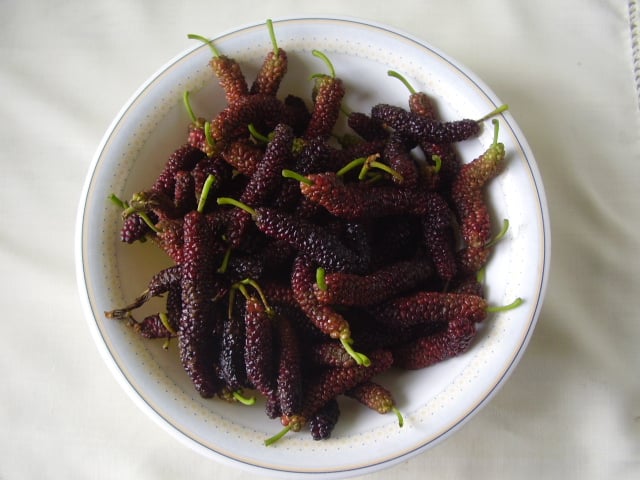
Long mulberry
The taxonomy of Morus is complex and disputed. Over 150 species names have been published, and although differing sources may cite different selections of accepted names, only 10–16 are generally cited as being accepted by the vast majority of botanical authorities. Morus classification is even further complicated by widespread hybridisation, wherein the hybrids are fertile.
These species are accepted by the Kew Plant List as of August 2015:[5]
Morus alba L. – White mulberry (China, Korea, Japan)
Morus australis Poir. – Chinese mulberry (China, Japan, Indian Subcontinent, Myanmar)
Morus cathayana Hemsl. – China, Japan, Korea
Morus celtidifolia Kunth – (North and South America)
Morus indica - L. – India, Southeast Asia
Morus insignis - Bureau – Central America and South America
Morus japonica Audib. – Japan
Morus liboensis S.S. Chang – Guizhou Province in China
Morus macroura Miq. – Long mulberry (Tibet, Himalayas, Indochina)
Morus mesozygia Stapf – African mulberry (south and central Africa)
Morus mongolica (Bureau) C.K. Schneid. – China, Mongolia, Korea, Japan
Morus celtidifolia – Texas mulberry South America, Central America, Mexico, Southwestern United States
Morus nigra L. – Black mulberry (Iran, Caucasus, Levant)
Morus notabilis C.K. Schneid. – Yunnan and Sichuan Provinces in China
Morus rubra L. – Red mulberry (eastern North America)
Morus serrata Roxb. – Tibet, Nepal, northwestern India
Morus trilobata (S.S. Chang) Z.Y. Cao – Guizhou Province in China
Morus wittiorum Hand.-Mazz. – southern China
Distribution and cultivation
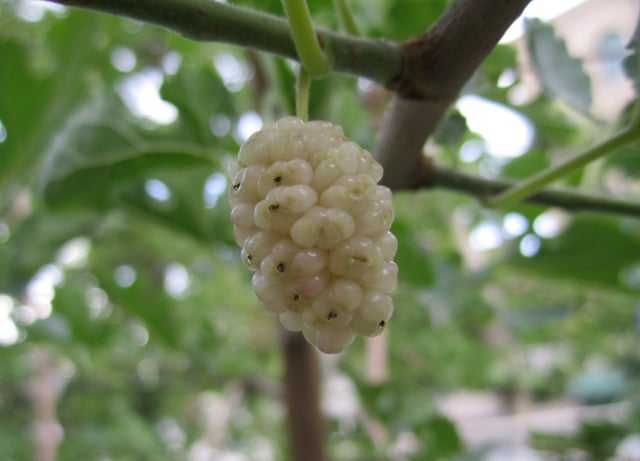
White mulberry
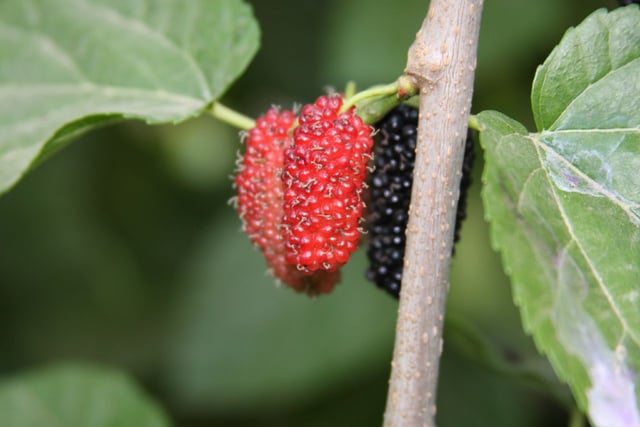
Mulberry fruit in Libya
Black, red, and white mulberries are widespread in Southern Europe, the Middle East, northern Africa, and the Indian subcontinent, where the tree and the fruit have names under regional dialects. Jams and sherbets are often made from the fruit in this region. Black mulberry was imported to Britain in the 17th century in the hope that it would be useful in the cultivation of silkworms. It was much used in folk medicine, especially in the treatment of ringworm. Mulberries are also widespread in Greece, particularly in the Peloponnese, which in the Middle Ages was known as Morea, deriving from the Greek word for the tree (μουριά, mouria).
Mulberries can be grown from seed, and this is often advised, as seedling-grown trees are generally of better shape and health, but they are most often planted from large cuttings, which root readily. The mulberry plants allowed to grow tall have a crown height of 1.5 to 1.8 m (5 to 6 ft) from ground level and a stem girth of 10–13 cm (4–5 in). They are specially raised with the help of well-grown saplings 8–10 months old of any of the varieties recommended for rainfed areas like S-13 (for red loamy soil) or S-34 (black cotton soil), which are tolerant to drought or soil-moisture stress conditions. Usually, the plantation is raised and in block formation with a spacing of 1.8 by 1.8 m (6 by 6 ft), or 2.4 by 2.4 m (8 by 8 ft), as plant-to-plant and row-to-row distances. The plants are usually pruned once a year during the monsoon season to a height of 1.5–1.8 m (5–6 ft) and allowed to grow with a maximum of 8–10 shoots at the crown. The leaves are harvested three or four times a year by a leaf-picking method under rain-fed or semiarid conditions, depending on the monsoon. The tree branches pruned during the fall season (after the leaves have fallen) are cut and used to make durable baskets supporting agriculture and animal husbandry.
Some North American cities have banned the planting of mulberries because of the large amounts of pollen they produce, posing a potential health hazard for some pollen allergy sufferers.[6] Actually, only the male mulberry trees produce pollen; this lightweight pollen can be inhaled deeply into the lungs, sometimes triggering asthma.[7][8] Conversely, female mulberry trees produce all-female flowers, which draw pollen and dust from the air. Because of this pollen-absorbing feature, all-female mulberry trees have an OPALS allergy scale rating of just 1 (lowest level of allergy potential), and some consider it "allergy-free".[7]
Mulberry tree scion wood can easily be grafted onto other mulberry trees during the winter, when the tree is dormant. One common scenario is converting a problematic male mulberry tree to an allergy-free female tree, by grafting all-female mulberry tree scions to a male mulberry that has been pruned back to the trunk.[9] However, any new growth from below the graft(s) must be removed, as they would be from the original male mulberry tree.[10]
Uses
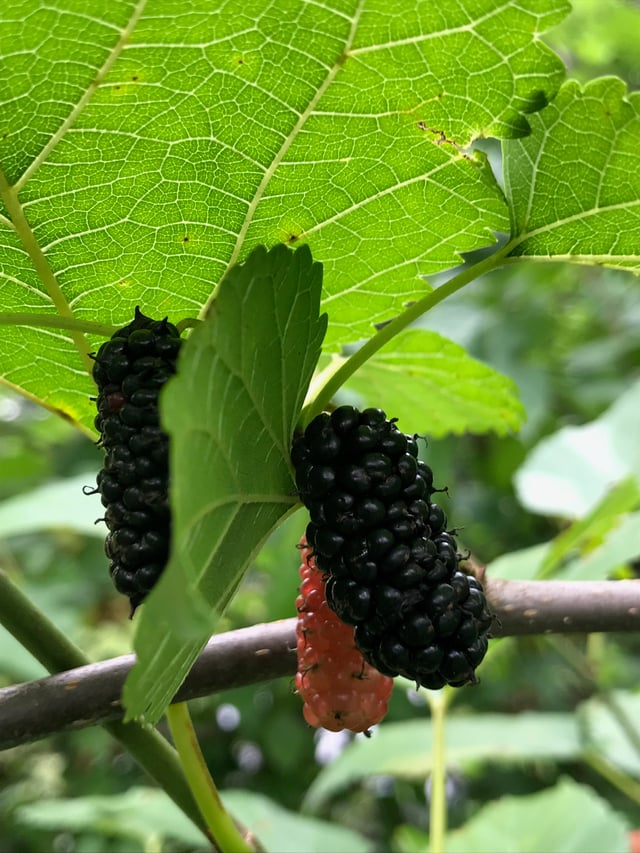
Mulberry in southern Brazil – known as amorinha[14]
The fruit of the white mulberry – an East Asian species extensively naturalized in urban regions of eastern North America – has a different flavor, sometimes characterized as refreshing and a little tart, with a bit of gumminess to it and a hint of vanilla.[11][12] In North America, the white mulberry is considered an invasive exotic and has taken over extensive tracts from native plant species, including the red mulberry.[13]
The ripe fruit is edible and is widely used in pies, tarts, wines, cordials, and herbal teas. The fruit of the black mulberry (native to southwest Asia) and the red mulberry (native to eastern North America) have the strongest flavors, which have been likened to 'fireworks in the mouth'.[11]
Nutritional profile
In a 100g (3.5oz) serving, raw mulberries provide 180 kJ (43 kcal), 44% of the daily value (DV) for vitamin C, and 14% of the DV for iron; other nutrients are in insignificant quantity (see table).
Silk industry

A silkworm, Bombyx mori, feeding on a mulberry tree
Mulberry leaves, particularly those of the white mulberry, are ecologically important as the sole food source of the silkworm (Bombyx mori, named after the mulberry genus Morus), the cocoon of which is used to make silk.[17][18] The wild silk moth also eats mulberry.[19][20] Other Lepidoptera larvae—which include the common emerald, lime hawk-moth, sycamore moth, and fall webworm—also eat the plant.[21]
Pigments
Mulberry fruit color derives from anthocyanins, which are under basic research for mechanisms of various diseases.[22][23] Anthocyanins are responsible for the attractive colors of fresh plant foods, including orange, red, purple, black, and blue. These colors are water-soluble and easily extractable, yielding natural food colorants. Due to a growing demand for natural food colorants, their significance in the food industry is increasing.
A cheap and industrially feasible method has been developed to extract anthocyanins from mulberry fruit that could be used as a fabric dye or food colorant of high color value (above 100). Scientists found that, of 31 Chinese mulberry cultivars tested, the total anthocyanin yield varied from 148 to 2725 mg/l of fruit juice.[24] All the sugars, acids, and vitamins of the fruit remained intact in the residual juice after removal of the anthocyanins, so the juice could be used to produce juice, wine, and sauce.
Anthocyanin content depends on climate and area of cultivation, and is particularly high in sunny climates.[25] This finding holds promise for tropical countries that grow mulberry trees as part of the practice of sericulture to profit from industrial anthocyanin production through the recovery of anthocyanins from the mulberry fruit.
This offers a challenging task to the mulberry germplasm resources for
exploration and collection of fruit yielding mulberry species
their characterization, cataloging, and evaluation for anthocyanin content by using traditional, as well as modern, means and biotechnology tools
developing an information system about these cultivars or varieties
training and global coordination of genetic stocks
evolving suitable breeding strategies to improve the anthocyanin content in potential breeds by collaboration with various research stations in the field of sericulture, plant genetics, and breeding, biotechnology and pharmacology
Paper
During the Angkorian age of the Khmer Empire of Southeast Asia, monks at Buddhist temples made paper from the bark of mulberry trees. The paper was used to make books, known as kraing.[26]
In culture
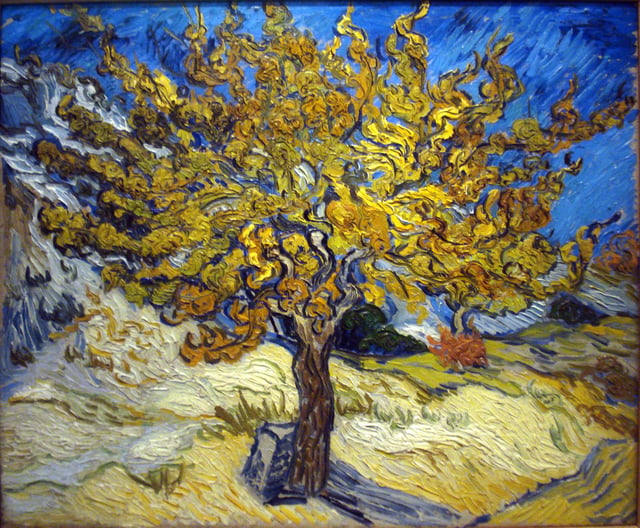
Mulberry Tree by Vincent van Gogh, 1889
A Babylonian etiological myth, which Ovid incorporated in his Metamorphoses, attributes the reddish-purple color of the mulberry fruits to the tragic deaths of the lovers Pyramus and Thisbe. Meeting under a mulberry tree (probably the native Morus nigra),[27] Thisbe commits suicide by sword after Pyramus was killed by the lioness because he believed that Thisbe was eaten by her. Their splashed blood stained the previously white fruit, and the gods forever changed the mulberry's colour to honour their forbidden love.[27]
The nursery rhyme "Here We Go Round the Mulberry Bush" uses the tree in the refrain, as do some contemporary American versions of the nursery rhyme "Pop Goes the Weasel".
Vincent van Gogh featured the mulberry tree in some of his paintings, notably Mulberry Tree (Mûrier, 1889, now in Pasadena's Norton Simon Museum). He painted it after a stay at an asylum, and he considered it a technical success.[28]
Fossil record
Fossils of Morus are reported from the Pliocene of the Netherlands.[29]
